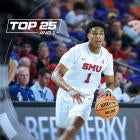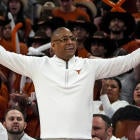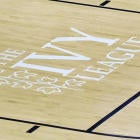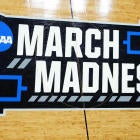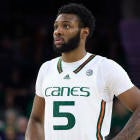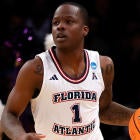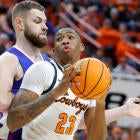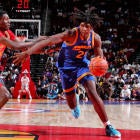BROOKLYN, N.Y. -- He unfolded out of the stands, all 85 inches of him, made his way down to the floor, sauntered through the Green Room -- to which he was not invited -- then beamed a smile as he strutted on to the stage. Thon Maker, the surprise 10th pick of the 2016 draft.
In the process, the Sudanese-cum-Australian-cum-American five-star basketball prospect might have changed the course of college hoops for the near future.
The Bucks' selection walked past more than a dozen guys in that green room. Guys who spent a year or two or four in college. He never did, and now he'll get paid more than all of them.
"Some of the guys looked at me sideways," Maker said. "Some of the guys I already knew from high school, so we were like friends. So they were happy and some guys gave me dap. And other guys were like, it should be them. I don't know, if I were in that situation, I would have been like, congrats, you know, you've made a step. Now go make a name for yourself."
To an extent, Maker already has. A year ago, no one predicted this. Maker's path to the draft was burdened and smoke-screened by eligibility concerns for college. Some draft evaluators thought Maker might hang around until the late 20s. But no, another svelte stretch forward suffered that fate. As Maker shook Adam Silver's hand, Skal Labissiere watched on from below.
He'd sit for another 130 minutes before hearing his name called. It was the buzz at Barclays Center. A high-profile Kentucky player agonizingly having to wait ... and wait ... and wait.
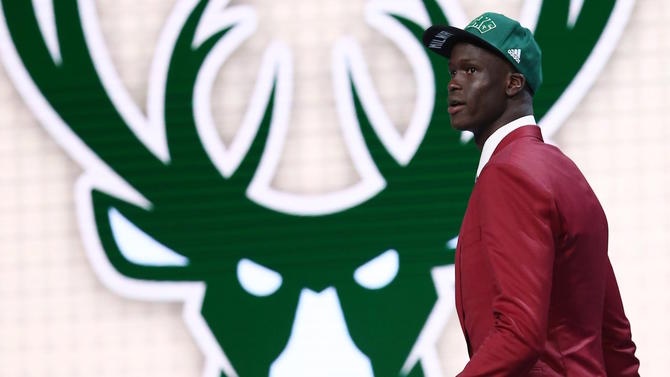
Labissiere sat across from his college coach, John Calipari, who was visibly stressed and occasionally burying his face in his hands. Kentucky players don't plummet, or at least they're not supposed to. But Labissiere's incredibly underwhelming freshman season at UK finally caught up to him. He went 28th, picked by the Suns and shipped to the Kings.
Maker's fortune and Labissiere's ill-fated night serve as an illuminating situation pertaining to recruiting, college basketball and how the template for planning a pro career could get updated in the coming months. On one hand, Labissiere could serve as a cautionary tale. (As could another five-star recruit who was a lottery pick on draft boards this time a year ago: Kansas' Cheick Diallo. He fell to the second round.)
Meanwhile, Maker's amiable personality, undeniable athleticism and dazzling game kept him in the first round. Late banter -- almost certainly misinformation about his age; he says he's 19 -- couldn't keep him out of the top 10. The rumors didn't slow Milwaukee from plucking Maker, and really, his rise and draft stock make the case for elite prospects to seriously consider skipping college if it means more guaranteed money.
What makes it even more interesting: Labissiere looked demonstrably better than Maker in the spring of 2015, when the two met at the annual Nike Hoop Summit. In 14 months' time, the dossiers on both changed dramatically. This is an incredible script flip. And let me be clear: As recently as a week ago, nobody had this. Nobody had Labissiere below the high 20s, really, and few people actually believed Maker could crack the top 10.
Let's bring it back to college hoops. What could be happening here? Well, if you're a five-star player, and you see what happened for Maker, and you see what happened to Labissiere and to Diallo, why don't you consider following Maker's path? He stayed back a year at the prep level to play with his younger brother. In doing so, he made himself eligible by age (19) to declare for the draft without ever having to take the college route. It unquestionably was the right move, especially when you consider Maker's stock now is even lower than Labissiere's a year ago, when Skal was projected as a top-five pick by just about everyone.
So will elite prospects begin to do this, to follow the Maker model? Not by majority, no way. But these conversations will be happening between players, handlers, parents. No doubt about it. It would be smart business practice for them -- and bad business for college basketball.
Don't get me wrong here: I'm not saying this is going to jumpstart a revolution. But it could materialize a concentrated pattern. At the very least, five-star prospects who can stay an extra year at a prep (or pop-up) school could help themselves by not exposing themselves to Division I basketball. It is irrefutable that Labissiere tanked his stock by choosing to play college basketball. He's not the only one. Consider his position, his body type and how similar it is to Maker and Diallo.
If Labissiere had a chance to do it all over again, would he really opt to play at Kentucky for a year and lose out on millions? No shot. And it's not as if returning to UK -- which will have a stronger roster with better big men next year -- would have helped Labissiere's situation.
Until NBA scouts and general managers prove with their draft-night decisions that this route won't pay off for the promising recruit, why shouldn't it be on the table?
A year ago, Maker was a YouTube sensation of a prospect who seemed to be on his way to playing and, maybe, starring in college. He was a player with a lot of potential and all the highlights to wow, but not necessarily a surefire one-and-done superstar. Last June, Labissiere was considered the No.1 player in the high school class of 2015, a surefire future top-10 pick.
Didn't work out that way. Labissiere's fall became the story of Thursday night's draft, though his night was mostly a happy one. We're talking about a kid who was once pinned in his own home by the rubble brought on by a massive earthquake. He's seen dark days, and now he'll be paid millions to try and stay on in the NBA. But still, there's no getting around what his promise was. I saw him play in the summer of 2014. I remember that player. I remember thinking he was the most NBA-ready in terms of skill set of any player in his class.
That is not the player I saw at Kentucky last year.
Maker going No. 10 was a shocker, but Labissiere falling to No. 28 was even more stunning. The former stayed back a year, skipped college, and it paid off for him. The latter was a No. 1 prospect in his class according to many, got exposed at a major program, and in the end that cost him millions, at least in the short-term.
The more teams see you, the more it can hurt you. Maker was coveted because of what he never showed he could do on the college level, while Labissiere was punished for it. Right now, there are a handful of top players who have to be thinking twice about committing to college when this alternative could be a legitimate option come 2017, 2018 and beyond.













